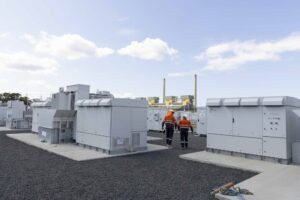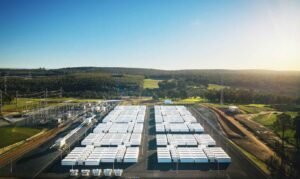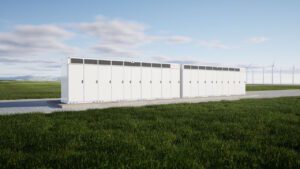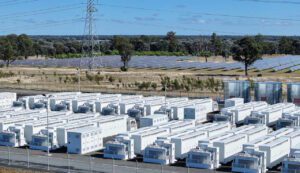See also our Explainer: What Tesla’s batteries can and cannot do, including costs, specifications.
Elon Musk has made a habit, and many billions of dollars, out of being able to do what others say is impossible. He has proven you don’t have to be a government-owned space agency to deliver payloads into space. He was the first to show that you can build an electric vehicle with mass market appeal.
He’s got another couple of doubt-defying projects on his list too: sending humans to Mars is one. Finding a cure-all for South Australia’s electricity woes is another. Of primary concern to most energy users in Australia, though, is this question: Can Elon Musk break apart the gas cartel currently controlling electricity prices?
There is no doubt now that wind and solar will provide the cheapest forms of new generation in the electricity market, but their ability to lower prices significantly is impacted because the bidding of wholesale prices is still controlled by the gas cartel.
These generators, because they are controllable and dispatchable, are able set the marginal price, and they have been ruthless in exploiting this market power. They have been accused by retailers, by networks and by politicians of manipulating those markets by deliberately withholding capacity and rebidding prices from low to high.
The addition of battery storage means that large-scale wind and solar farms now have that added capability of full dispatchability, and the addition of a new player or players will increase competition, because it needs only a few megawatts, in a system using thousands, to alter the price significantly.
That’s why Musk now has the opportunity to break open that cartel. The South Australian battery storage installation announced on Friday will quickly have an impact – around 70MW is assigned to what is known as the FCAS market, for grid stability, and another 30MW, with three hours storage, for the wholesale energy markets. (See our detailed explainer here).
That is going to give the main generators something to think about. Indeed, they’ve probably been thinking about this for some time now, which is why the massive electricity price rises pushed through to electricity consumers across the country last week may have the appearance of a massive own goal, but were probably more about their last opportunity to line their pockets.
Remember how Christoph Ostermann, the founder and CEO of Germany’s battery storage developer Sonnen, expressed his astonishment (and delight) that the utilities would push up prices just as he launched his own battery storage product to households, effectively offering free power, with a very low fee, once the cost of the battery storage purchased by the consumer is amortised.
“We’re going to put them out of business,” Osterman declared, saying the utilities will struggle with the concept of “free” electricity flowing from rooftop solar and storage devices. He said he couldn’t believe his luck when he saw utilities jack up prices by nearly 20 per cent in the same week as his product launch.
If the big utilities are worried, they are too busy making huge profits to show it. Over the past 12 months, they have engineered a massive transfer of wealth from consumers to their own shareholders – a transfer that is locked in the system for several years. They are making hay while the sun still shines. And how.
According to Morgan Stanley figures, the margins of AGL Energy alone will likely rise by some $600 million over the next three years because – barring a massive collapse in futures prices – it will take years for the current increases in the system to work their way through, thanks to hedging and customer contracts.
That boost to Ebitda (earnings before interest, depreciation and tax) could jump to more than $800 million if future prices jump another $10/MWh. Even if futures prices fell $10/MWh below current predictions, Morgan Stanley estimates AGL’s gain from the recent prices would still be around $300 million.
The Origin numbers are not far behind, and if EnergyAustralia are in the same ball park, and Snowy Hydro and others, then some $2 billion is being transferred from consumers to the big utilities.
That’s bad news for consumers, because those increases have not yet flowed through to their customer bills, despite the near 20 per cent increases in the past week.
More price rises will be repeated again next year, and maybe even the following year before it is shaken out of the system, and when the current boom in wind and solar comes on line, and more battery storage is added.
Many predict that these price rises will trigger an exodus of customers to the likes of Sonnen and other innovative providers, but even losing tens of thousands of customers will not outweigh the benefits gained by the big gen-tailers from the price hikes.
Brazenly, the big gen-tailers have blamed the bill shock on rises in wholesale prices.
But who is to blame for the rises in the wholesale market? According to major network operators and some small retailers, it is the generators themselves. Gas prices are also being blamed. And who is causing the rise in gas prices? Mostly the very same companies.
Anyone doubting the ability of the generators to control prices only has to look at developments in Queensland, where the energy minister Mark Bailey intervened to tell the government-owned generators to desist in their bidding practices.
Queensland has gone from rivalling South Australia, with the highest wholesale prices of this financial year (and 2015/16), to having the lowest – almost 40 per cent below their levels of March and 30 per cent below other states. A new study suggests they have pocketed an extra $1.5 billion from their bidding practices.
It is clear that the generators are now under attack from the small retailers, the networks, and the politicians. And they are subject to an investigation from the Australian Competition and Consumer Commission. Pretty soon, the theory goes, they will also be under attack from their own customers, whose pockets they are emptying.
Already round 1.7 million homes have rooftop solar, and that number is being added to at record rates. Alternative business models like Sonnen’s will make it easier for consumers to go elsewhere.
Businesses are also adding rooftop solar at unprecedented rates across the country, and the big energy users are also turning to renewables and storage to duck the bill shock imposed by the generators.
So perhaps this is not a massive own goal after all. The utilities, seeing the plunging cost of wind and solar and battery storage, and the inevitable assault on their business models, have decided to go out with a bang, with one very big bite of the cherry before they have to go through the hassle of re-inventing themselves.
Ironically, by pushing up prices and lining their pockets at the expense of the consumers, the transition will be accelerated – although given the regulatory influence they hold, and their past ability to fight against carbon pricing, renewable targets, energy efficiency and demand management, the transition will get messy.
It will happen.
Australian consumers, as Bruce Mountain reveals, are paying a ridiculous price for grid power: combined with fixed network costs, the price of a kilowatt of electricity is not 30c/kWh, as many assume.
That’s expensive enough, but the real cost is closer to 40c/kWh, about the same cost as burning diesel in a genset – there can be no more damning statistic than that on the failure of Australia’s coal-based electricity grid.
It’s not just the consumers that are suffering. The bidding practices and wholesale price surge is making life difficult for the smaller retail players without their own generators. The competition is being swamped.
The likes of Enova and Energy Locals, new community-based companies have so far laid barely a scratch on the big boys. “They can just get away with it because they can. Nothing else has changed in the market,” says Steve Harris, the founding CEO of Enova, who retired this week.
The alternative for small retailers is to invest in their own generation, which is what Enova is doing with its own customers. It will be renewable and it will be storage. But it won’t be 500MW power stations; it will be lots of 5kW power stations with battery storage – like sonnen’s and Tesla’s (and some large arrays).
The more renewables that are built, the less reliant the companies are on wholesale prices. Bit by bit, they will eat away at the margins of the big players. And once the current high prices have worked their way through the system, then the business models will really be under pressure.
Some, though, are not quite finished and want to come back for more.
The fossil fuel mining lobby – and their proxies in the Coalition and the Murdoch media – are pushing for yet more coal-fired generators; they want restrictions on renewable energy, and are fighting against rule changes that would reduce their ability to manipulate the market.
The former Coalition energy minister, Ian Macfarlane, now lobbyist for the fossil fuel industry in Queensland as head of the Queensland Resources Council, wants not just one but three new coal-fired generators to be built over the next decade as old generators retire.
He warned this week of power outages and industry shut-downs unless two or three new coal generators were built, and ensured a “smooth” (read drawn-out) transition to renewables that was not hijacked by foreign-funded greenie extremists.
Macfarlane wants the share of renewable energy to be restricted to around 35 per cent. Given that the likes of the CSIRO and others think that half of all generation will come “behind the meter” from rooftop solar, Macfarlane is effectively arguing for a cap on rooftop solar.
And yet Macfarlane, the Murdoch media reports, has solar scattered across the roof of his Toowoomba home. Does this suggest that solar is good enough for him but not for the all the public? To borrow a phrase from Marie Antoinette when the Bourbon dynasty’s business model was coming to an end: “Let them eat coal.”
The profits may be growing, but the revolution is nigh.









